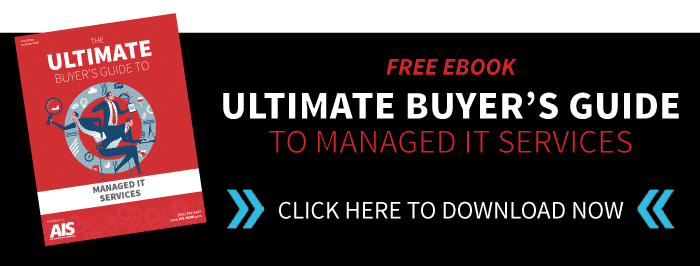Managed IT Providers: Your Relationship Is Like Your Bank
January 30th, 2020 | 8 min. read

We’ve been marketing to and working with SMBs (small to medium-sized businesses) for a few years now. When listening to customers, their relationship with a Managed IT Provider or Managed Services Provider (MSP) seems strikingly similar to our own personal and business relationships with banks.
Hear me out...
Marketing 101 and Some History
In marketing to prospects (attracting and acquiring new customers), when performing our initial research on a group of business owners, we do normal marketing activities that include:
- Researching A Target Audience: We begin by getting to know what the perfect customer and audience is for our line-of-work or business.
- Create Buyer Personas: We create different types of profiles for each of the decision-makers we want to reach. It’s basically a blueprint or dossier on all of the demographics of our perfect customer. We even build “negative buyer personas” for the specific customers we don’t want to do business with, or we cannot help (i.e., they may be too large, small, outside our service area, etc.).
For us to get to know our audience, we do normal marketing research activities or “stalking” to:
- Identify their traits like age, title, education, etc.
- Find out what business information they read or consume on a daily basis.
- Learn what sites they frequent.
- Discover what events they like to congregate at.
- Study how they like to get their information (what types of portals, social media sites.)
- We even like to find out what time of day they like to read this information.
It does seem like stalking, right?
It is, but we do this so we can understand the buyers and decision-makers. The goal is to communicate with them and try NOT to interrupt their daily business responsibilities or routine. We are trying to be considerate of their time and business.
We do many other activities, and they all result in us in the development of a Target Customer Profile (TCP). These activities ensure that we stay focused on building marketing programs and activities like email, advertising, and communications to reach our target audience.
Once we have built our profiles, we are ready to design programs and implement activities to connect with prospects. However, this can be challenging. Take a look at some less-than-perfect implementations or how some marketers have not always executed specific programs.
Yes, Marketers Have Ruined Everything for Everyone
Marketers aren’t bad guys, although we have ruined many things for many people.
For example, we are the ones that exploit email and cram your inbox daily. We even flood you with ads for a specific product on your favorite social media site immediately after heard you talking about it when we are eavesdropping on your conversations when your phone is nearby or you were just searching online for it.
SORRY!
But that is because you won’t let us solicit your business any longer, or you continually duck our telemarketer’s calls or LinkedIn connection requests! ;)
And I don’t blame you. We were the ones that created SPAM.
How about that LinkedIn person that asks for a connection with you, and as soon as you accept, they send you a message trying to sell you. That’s a FAIL! If you know anyone that is using this tactic, keep this link handy: Just Because I Connect with You on LinkedIn Doesn’t Mean I Want You to Sell Me.
Our goals are to understand your business, the problems you are facing, and how we can support your technology needs. We want to help you plan for the future by reaching out and starting a conversation.
But it’s not that easy—let me tell you why.
Understanding How You Got Here and What Does This Have to do with MSPs and Banks?
First of all, if you are like most small to medium-sized businesses’, your IT support and services were most likely started by the owner or a family member. As your business grew, you may have found that these technology services have turned into a full-time job.
How do we find a bank or an MSP that we want to do business with today?
Search: You perform a Google search for help for a local Managed IT service provider or bank. Or, you may search for the types of services you need (maybe to answer a few of your IT or financial services questions.)
Locality: You want someone local to support your business, not across the country or on the other side of the globe. Even better, is a managed IT services company that also offers a wide range of remote support or consulting services through a call or data center.
Convenience: You want someone that is not too big, so they answer your phone calls and give you the attention you deserve. You deserve to be treated like you are their only customer. If you are looking for this type of service from your bank, good luck. You may have to go to a credit union.
Referral: You may get a referral from another business or friend of their favorite business or experience.
Services: You want to find the right business that provides the services (such as cloud services or cloud computing) that you need and use most frequently.
Cost: You want it at the best price. By the way, we want this too. What provider would want to tax your business with such high rates that it takes away from the profit of your business to fuel your growth? If we are unreasonably expensive, it puts you out of business, which does not help either of us. We all win if our goals are aligned.
How Hard is it to Change Banks or MSPs?
Why would you ever change a bank or an MSP once you have a relationship? Here are a few:
- Growth: Your business has outgrown the provider, and you need more from them. How has your current MSP improved your company’s backup and disaster recovery plan since the addition of new employees?
- Lack of Service: You aren’t getting the service you believe you deserve or need, and not feeling like you are as important to them. They may be servicing more customers now.
- Cost: Their services have become too costly. Their prices have gone up over time, but they may still be offering you the same services since you began—and when you ask for more, the costs are too high.
Or how about, the mentality of, “There’s nothing wrong, so why fix it?” mentality. What’s wrong with this attitude?
There are a few things wrong with this approach. For starters, monitoring your systems on a proactive basis is a much safer way to keep your network infrastructure up and running opposed to only reacting once a problem occurs.
Technology changes quickly, and it does not wait for you or your business to catch up. You need experts to stay on top of these changes and to understand how your business can leverage the right changes to meet your business goals.
Do you ever plan with information technology? Do you know how quickly it is evolving? What new tools are available to protect your business from phishing scams, cybersecurity, network holes, and exploits? What forms of network security services do they offer? Have you considered getting IT experts to help you with a technology road map?
It might seem like these services are too expensive or sophisticated for your business. But it can be done very cost-effectively. You owe this to your business, just like hiring the right people for the right positions in your organization.
Related: IT Help: How to Successfully Switch Managed IT Services Providers.
Why is it so difficult to leave or change banks or MSPs?
- Accounts: You have multiple accounts, and if you make a change, it could take way too much work to go to a new provider, or you may have the feeling like you are starting over.
- Passwords: With a change to a bank or an MSP, you are going to have to change all of your passwords to the accounts and notify all staff and partners. This might seem like more work than staying put.
- Service Differences: Each business, whether a bank or an MSP, does things a little differently. Does making a switch worth adapting to a new provider’s ways?
- Billing: Setting up a new account. Going through the credit process. Understanding how their fee structure works. You get the picture. This appears to be way more complicated and way out of your comfort zone.
- History: You have history. You know how your bank or your current IT provider works. It’s comfortable. You feel like they know your business, and it’s going to take too much effort for you to work with a new provider.
- Learning new ways of doing business: This is important because this is the fear of the unknown. You don’t know what you don’t know. In IT especially, you need a strong partner to keep your business upright. There are so many online threats and tech advancements that you aren’t even aware of.
The Final Word On Your Relationship With Managed Services Providers
So why is understanding this relationship so important? Well, because we want to help you grow your business and, at the same time, understand it and not disrupt it. You may be comfortable now using your “IT Guy” or local provider that you’ve had for years.
Just like your banking relationship, if you want to do your business justice, you should be reviewing this relationship every year or two. It is up to you to compare multiple service offerings, find out what other knowledge you can tap into, or just keep your current vendor on their toes.
The next time that an MSP reaches out to you, you may want to take that appointment. It doesn’t cost you a thing to listen to another provider or what they can do for you. You owe it to your business. Don’t you?
To learn more about managed IT services or what these services include, visit our Ultimate Resources Page. Or, reach out to us here. We're here to give you peace of mind to help you win more business.
Over the last 20+ years, Keven has had a passion in all areas of traditional and digital marketing. His main focus is how the consumer or decision makers see brands in order to develop successful programs to meet them on their turf. Prior to AIS, Keven has held senior marketing and communication posts in Financial Services, Technology, Communications, Biotech, and Lead Generation industries from start-ups to privately held and public companies. Today, he’s building a team to support the growth of AIS to become a leading brand in office technology. When not working, Keven can be found hacking his house, life, and those around him to make everything around him a better world. He volunteers his time as a Board Member for United States Diving and Ad Fontes Media.



